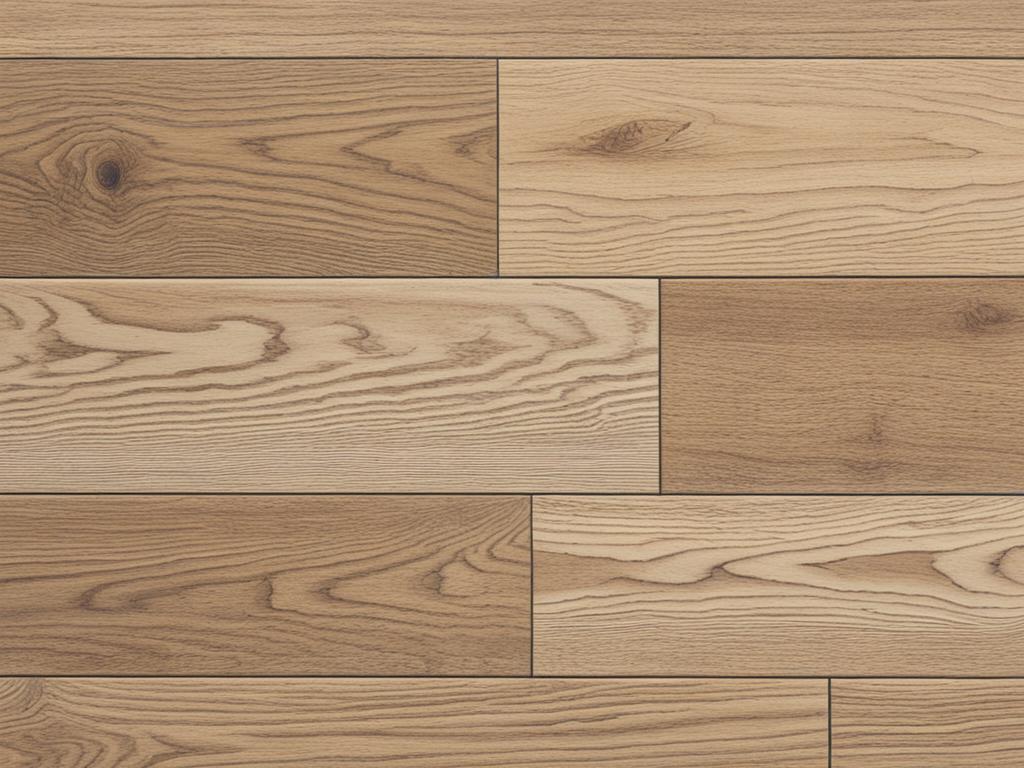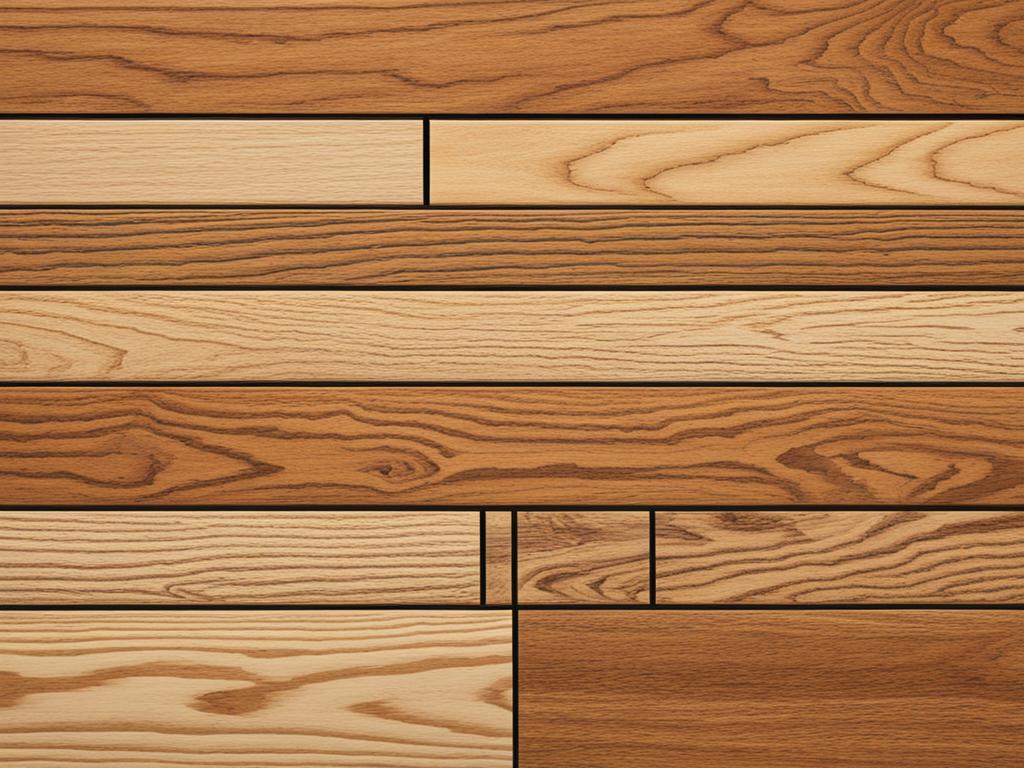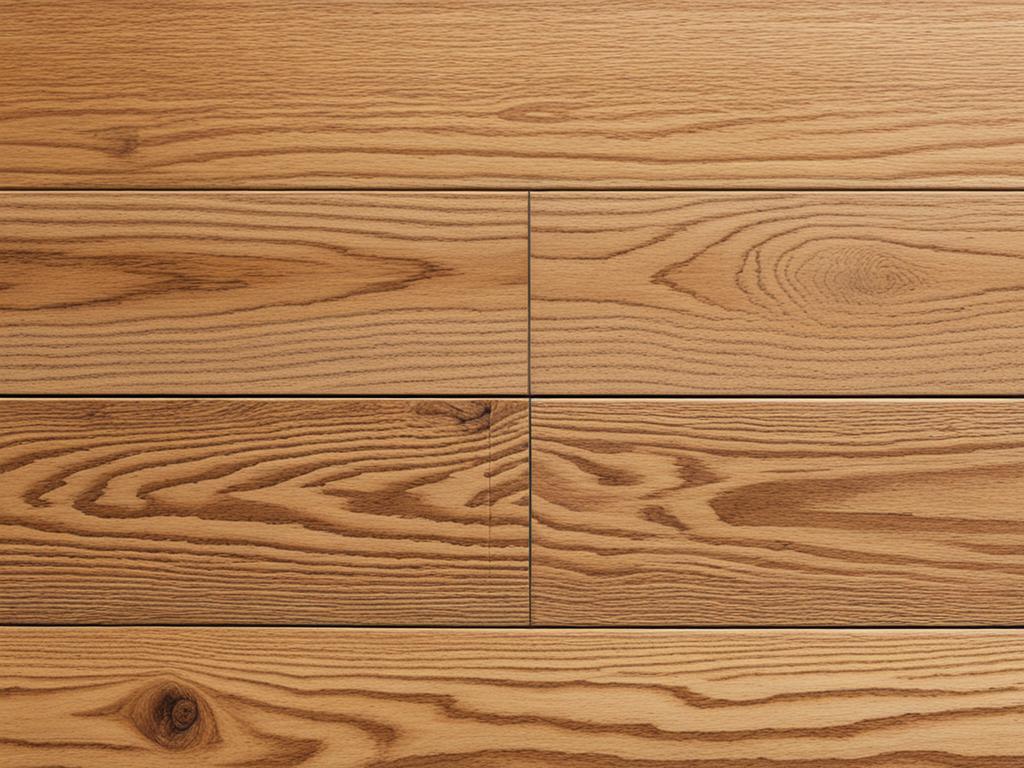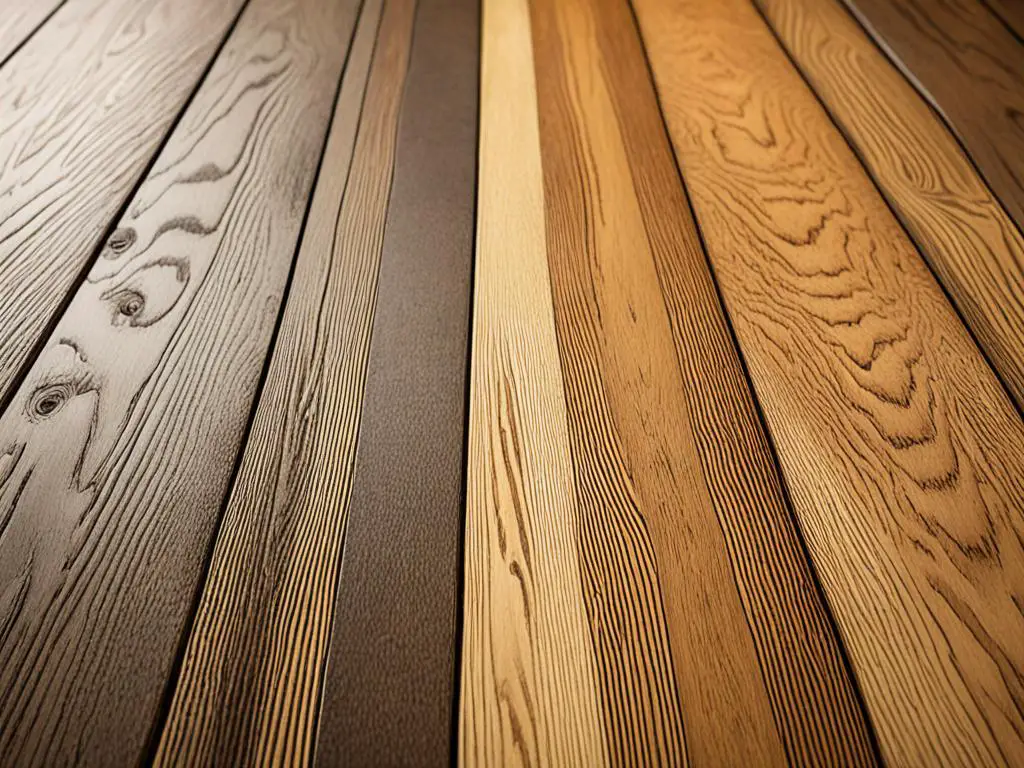When it comes to choosing hardwood flooring, one of the key decisions you’ll need to make is the thickness of the planks. The two main options are 1/2 inch and 3/4 inch. Understanding the differences between these thicknesses and the types of hardwood flooring available will help you make an informed decision for your home.
Key Takeaways:
- Choosing the right thickness of hardwood flooring is crucial for stability and durability.
- Solid wood flooring offers a traditional appeal and is available in thicknesses of 1/2 inch, 5/8 inch, and 3/4 inch.
- Engineered wood flooring is constructed with multiple layers and is available in thicknesses ranging from 3/8 inch to 3/4 inch.
- The dimensions and widths of hardwood flooring can vary between manufacturers.
- The wear layer thickness is important for determining the durability and maintenance of hardwood flooring.
Solid Wood Flooring: Stability and Thickness
Solid wood flooring offers a timeless and traditional aesthetic for your home. Contrary to popular belief, solid wood flooring can provide excellent stability, depending on the manufacturer and the quality standards applied to the product. The durability of solid wood flooring is one of its key benefits, making it a popular choice for homeowners.
The installation process of 1/2 inch, 5/8 inch, and 3/4 inch solid wood flooring is relatively straightforward. It can be installed over various types of surfaces, including radiant heat systems and concrete. This flexibility makes solid wood flooring a versatile option for different spaces in your home.
| Benefits of Solid Wood Flooring | Durability of Solid Wood Flooring |
|---|---|
|
|
With solid wood flooring, you can enjoy the benefits of a durable and visually appealing flooring option that adds value to your home. The stability and thickness of solid wood flooring make it a reliable choice for long-term use. Whether you prefer the classic look of oak, the warm tones of maple, or the richness of cherry, solid wood flooring offers a range of options to suit your style and preferences.
Quote:
“Solid wood flooring provides a timeless appeal and enduring durability. It’s a great investment that enhances the beauty and value of any space.” – Chris Johnson, Flooring Expert
Next, let’s explore engineered wood flooring and how it compares to solid wood flooring in terms of stability and thickness.
Engineered Wood Flooring: Stability and Thickness
When considering hardwood flooring options, engineered wood flooring offers several benefits, including stability, durability, and a wide range of thicknesses. This type of flooring is constructed with multiple layers of wood to achieve the desired thickness, making it a versatile choice for various applications.
One of the key advantages of engineered wood flooring is its stability. Unlike solid wood flooring, which can expand and contract with changes in temperature and humidity, engineered wood is more resistant to these fluctuations. This makes it a suitable option for areas with variable climates or moisture levels, such as basements or rooms with radiant heat systems.
The durability of engineered wood flooring is another notable advantage. With its multi-layer construction, engineered wood can withstand heavy foot traffic and resist warping, cracking, and cupping. This makes it a durable choice for high-traffic areas in residential and commercial settings.
Installation Process
The installation process for engineered wood flooring is relatively straightforward, whether you choose a click-lock or glue-down method. Click-lock engineered wood flooring features interlocking tongue-and-groove edges, allowing for easy installation without the need for adhesives. This type of installation is suitable for DIY projects or areas where temporary flooring may be desired.
Alternatively, glue-down installation involves adhering the engineered wood planks directly to the subfloor using a high-quality adhesive. This method provides a more permanent and secure installation, ideal for areas with heavy foot traffic or where moisture control is required.
The Importance of Thickness
The thickness of engineered wood flooring varies depending on the manufacturer and the specific product line. It is available in a range of options, typically ranging from 3/8 inch to 3/4 inch. The choice of thickness is important as it can affect the stability and durability of the flooring.
Thicker engineered wood flooring tends to offer better stability and durability. It can better withstand heavy use and provide a more solid feel underfoot. Thicker planks also allow for easier refinishing over time, providing the opportunity to refresh the appearance of your flooring if desired.
On the other hand, thinner engineered wood flooring may be more suitable for areas with height restrictions or where transitioning between different flooring surfaces is necessary. It is important to consider your specific needs and preferences when selecting the thickness of engineered wood flooring.
Overall, engineered wood flooring provides stability, durability, and a wide range of thickness options. Whether you choose a click-lock or glue-down installation method, this type of flooring offers versatility and timeless beauty for your home or commercial space.

Dimensions and Widths of Hardwood Flooring
When it comes to hardwood flooring, dimensions and widths play a crucial role in determining the overall appearance and style of your space. Different manufacturers offer varying options, with engineered wood flooring often presenting distinct characteristics compared to solid wood flooring.
Engineered wood flooring is commonly available in shorter and narrower boards, typically measuring about 2 feet in length. While this can create more seams and joints, leading to a slightly busier look, some manufacturers provide engineered wood flooring in widths and lengths similar to those of solid wood flooring. This allows for a more visually appealing and cohesive aesthetic.
Let’s take a closer look at the dimensions and widths of hardwood flooring through a comparative table:
| Hardwood Flooring Type | Average Length | Average Width |
|---|---|---|
| Engineered Wood Flooring | About 2 feet | Narrower width compared to solid wood flooring |
| Solid Wood Flooring | Various lengths available | Wider width compared to engineered wood flooring |
The information in the table highlights the general differences in dimensions and widths between the two types of hardwood flooring. While engineered wood flooring tends to have narrower dimensions, solid wood flooring offers more options in terms of length and width.
Remember that specific measurements may vary based on the manufacturer and product line, so it’s essential to consult with a flooring professional or refer to the manufacturer’s specifications for accurate details.
Enhancing the Visual Appeal of Hardwood Flooring
Choosing the right dimensions and widths for your hardwood flooring is crucial for creating a harmonious and visually appealing space. Consider the following factors when making your decision:
- The size of the room: Larger rooms can accommodate wider and longer planks, enhancing the overall balance and openness.
- The style of your home: Traditional or rustic homes often benefit from wider planks, while narrower planks can suit contemporary or minimalist designs.
- The installation method: Different installation techniques may affect the suitability of certain dimensions and widths, so consult with a professional to ensure proper installation.
By carefully considering these factors and the specifics of your space, you can choose the dimensions and widths of hardwood flooring that best complement your home’s style and create a visually appealing environment.

Next, let’s explore another important consideration when selecting hardwood flooring: the wear layer thickness. As we’ll discover, this layer plays a significant role in the overall durability and maintenance of your new flooring.
The Importance of Wear Layer Thickness
When it comes to choosing hardwood flooring, the wear layer thickness is a crucial factor to consider. The wear layer refers to the thickness of the material above the tongue and groove that you walk on. This layer directly affects the durability, maintenance requirements, and overall cost of the flooring.
A thicker wear layer offers several benefits, making it a desirable choice for homeowners. Firstly, it provides enhanced durability, making the floor more resistant to wear and tear, scratches, and dents. This is especially important for high-traffic areas or homes with pets or children.
Additionally, a thicker wear layer allows for refinishing if needed. Over time, hardwood floors may start to show signs of aging, such as fading or scratches. With a thicker wear layer, the floor can be sanded down and refinished, restoring its original beauty without the need for costly replacement. This not only prolongs the lifespan of the flooring but also adds value to your home.
On the other hand, engineered wood flooring typically has a thinner wear layer. While engineered wood floors offer other advantages such as versatility and ease of installation, the thin wear layer means they may wear more quickly and cannot be refinished as many times as hardwood floors with a thicker wear layer.
Choosing hardwood flooring with a thicker wear layer can result in a longer-lasting floor, reducing the need for frequent replacement and saving you money in the long run. Not only does it provide increased durability and the option for refinishing, but it also contributes to the overall maintenance of your flooring.
Cost Comparison
While hardwood flooring with a thicker wear layer may have a slightly higher initial cost compared to thinner wear layers, it offers significant cost advantages in the long term. The ability to refinish the floor multiple times extends its lifespan, reducing the need for replacement. This means you won’t have to invest in new flooring as frequently, saving you money in the long run.
Furthermore, hardwood flooring with a thicker wear layer generally requires less maintenance over time. It can withstand heavy foot traffic, resist scratches, and maintain its beauty for longer periods, reducing the need for repairs or touch-ups.
Here is a cost comparison between 1/2 inch and 3/4 inch hardwood flooring:
| Cost Comparison | 1/2 inch Hardwood Flooring | 3/4 inch Hardwood Flooring |
|---|---|---|
| Initial Cost | $$ | $$$ |
| Long-Term Cost | $$ | $ |
| Refinishing Capability | Limited | Ability to refinish multiple times |
| Maintenance | More frequent maintenance required | Reduced maintenance needs |
As seen in the cost comparison table, while 1/2 inch hardwood flooring may be more affordable upfront, it may require more frequent maintenance and replacement over time due to wear. In contrast, 3/4 inch hardwood flooring offers a higher upfront investment but provides long-term cost savings through its durability, refinishing capabilities, and reduced maintenance needs.
In conclusion, selecting hardwood flooring with a thicker wear layer is a wise decision for homeowners looking for durability, longevity, and cost-effective flooring solutions. By investing in a thicker wear layer, you can enjoy a beautiful and resilient hardwood floor that will stand the test of time without breaking the bank.

Factors to Consider for Choosing the Right Hardwood Flooring
When it comes to choosing the right hardwood flooring, there are several factors to consider. Whether you’re deciding between 1/2 inch or 3/4 inch thickness, these considerations will help you make an informed decision.
Stability and Durability
The stability and durability of hardwood flooring are essential factors to consider. Thicker planks, such as 3/4 inch, typically offer greater stability and can withstand heavier foot traffic without warping or buckling. However, 1/2 inch planks can still provide durability, especially in low-traffic areas or homes with proper subflooring.
Type of Installation
Another factor to consider is the type of installation you require. Above-grade installations, such as on the main level of your home, can accommodate both 1/2 inch and 3/4 inch hardwood flooring. However, for below-grade installations, like in basements, 1/2 inch flooring may be more suitable due to better moisture resistance.
Wood Species and Aesthetics
The choice of wood species impacts the overall aesthetics of your hardwood flooring. Some species, like oak or maple, are commonly available in both 1/2 inch and 3/4 inch options. Consider the color, grain pattern, and texture of different wood species to choose the one that best matches your interior design preferences.
Location and Specific Requirements
Take into account the location of your home and any specific requirements. For example, if you have a radiant heat system, 1/2 inch hardwood flooring may be a better choice as it allows for better heat transfer. If you have a concrete subfloor, both thicknesses are viable, but 1/2 inch may require an additional moisture barrier.
Installation Process
Finally, consider the installation process. If you have experience with DIY projects and have the necessary tools, you may be able to install either 1/2 inch or 3/4 inch hardwood flooring yourself. However, if you prefer professional installation, the availability of skilled installers and their expertise in handling different thicknesses should be considered.
By considering these factors, you can confidently choose the right hardwood flooring thickness for your home. Remember to assess stability and durability, the type of installation, wood species and aesthetics, location-specific requirements, and the installation process itself.
Cost Comparison and Long-Term Considerations
When considering the cost of 1/2 inch and 3/4 inch hardwood flooring, it’s important to understand that the difference is minimal. While thicker flooring may have a slightly higher initial cost, it offers long-term benefits that make it a worthwhile investment. One of the key advantages of thicker hardwood flooring is its durability. With a 3/4 inch thickness, the flooring is more resistant to wear and tear, making it less likely to require frequent replacement.
Another factor to consider is the ability to refinish the flooring. Thicker hardwood flooring, such as the 3/4 inch option, can be refinished multiple times throughout its lifespan. This means that if the floor becomes worn or damaged, it can be sanded down and restored to its original beauty. On the other hand, 1/2 inch hardwood flooring may not be able to withstand multiple refinishing processes, making it more limited in terms of maintenance and longevity.
When comparing the costs of 1/2 inch and 3/4 inch hardwood flooring, it’s important to look beyond the initial price tag. Consider the long-term maintenance requirements and potential for future repairs or refinishing. Thicker hardwood flooring may require less frequent replacement and offer the option for refinishing, which can save you money in the long run. In contrast, 1/2 inch hardwood flooring may require more frequent replacement due to wear and cannot be refinished as many times.
Below is a cost comparison table between 1/2 inch and 3/4 inch hardwood flooring:
| Hardwood Flooring Thickness | Average Cost per Square Foot (Installation Included) |
|---|---|
| 1/2 inch | $6 – $12 |
| 3/4 inch | $8 – $16 |
As seen in the table, there is a slight difference in cost between 1/2 inch and 3/4 inch hardwood flooring. However, considering the long-term benefits and potential savings in maintenance and replacement, the slightly higher cost of thicker hardwood flooring is often worth it.
Conclusion
When choosing between 1/2 inch and 3/4 inch hardwood flooring, it is crucial to consider various factors such as stability, durability, installation requirements, and personal preferences. Solid wood flooring and engineered wood flooring present distinct options, with solid wood offering a classic and long-lasting choice, while engineered wood provides versatility and easier installation.
The right thickness selection ultimately depends on your specific needs, preferences, as well as the location and requirements of your home. Solid wood flooring, available in thicknesses of 1/2 inch, 5/8 inch, and 3/4 inch, is renowned for its durability and ability to be installed over various surfaces. On the other hand, engineered wood flooring, featuring thicknesses ranging from 3/8 inch to 3/4 inch, is constructed with multiple wood layers, offering stability and flexibility in installation.
Consideration should also be given to the dimensions and widths of the hardwood flooring. While engineered wood flooring often has shorter and narrower boards, some manufacturers provide options that match the widths and lengths of solid wood flooring, resulting in a more visually appealing and cohesive appearance in your space.
Ultimately, the decision between 1/2 inch and 3/4 inch hardwood flooring should be based on careful assessment of your desired stability, durability, installation process, and personal preferences. It’s important to choose the right thickness that best suits your home and lifestyle to ensure long-lasting and aesthetically pleasing results.
FAQ
What is the difference between 1/2 inch and 3/4 inch hardwood flooring?
The main difference between 1/2 inch and 3/4 inch hardwood flooring is the thickness of the planks. 1/2 inch hardwood flooring is thinner, while 3/4 inch hardwood flooring is thicker.
What is solid wood flooring?
Solid wood flooring is made from one solid piece of wood and is known for its traditional and timeless appeal. It offers durability and can be installed over various types of surfaces, including radiant heat systems and concrete.
What is engineered wood flooring?
Engineered wood flooring is constructed with multiple layers of wood to achieve the desired thickness. It is often perceived as more stable than solid wood flooring and is available in various thicknesses. It is important to consider the backing and wear layer thickness when selecting engineered wood flooring.
How do the dimensions and widths of hardwood flooring differ?
The dimensions and widths of hardwood flooring can vary depending on the manufacturer. Engineered wood flooring is often available in shorter and narrower boards, resulting in more seams and joints. However, some manufacturers offer engineered wood flooring in the same widths and lengths as solid wood flooring.
What is the wear layer of hardwood flooring?
The wear layer of a hardwood floor refers to the thickness of the material above the tongue and groove that you walk on. A thicker wear layer provides more durability and allows for refinishing if needed.
What factors should I consider when choosing hardwood flooring?
When choosing between 1/2 inch and 3/4 inch hardwood flooring, factors to consider include stability, durability, installation requirements, wood species, personal aesthetics, location, and any specific requirements such as radiant heat systems or concrete subfloors.
How does the cost of 1/2 inch and 3/4 inch hardwood flooring compare?
The cost of 1/2 inch and 3/4 inch hardwood flooring can vary, but the difference is minimal. Thicker flooring may have a slightly higher initial cost, but it offers long-term benefits such as durability and the ability to be refinished.
What should I consider for long-term maintenance and cost?
Thicker hardwood flooring generally requires less frequent replacement and can be refinished multiple times, resulting in lower long-term maintenance costs. While 1/2 inch hardwood flooring may be more affordable upfront, it may require more frequent replacement due to wear and cannot be refinished as many times as 3/4 inch hardwood flooring.




